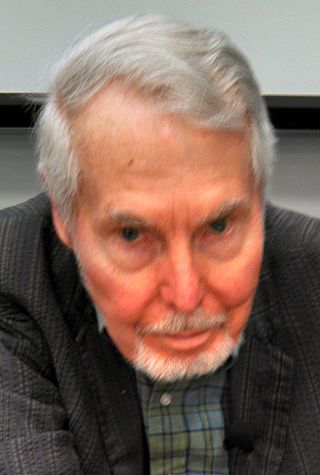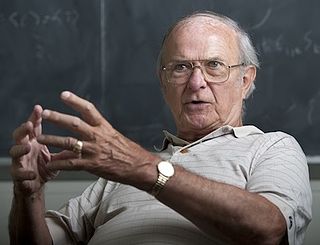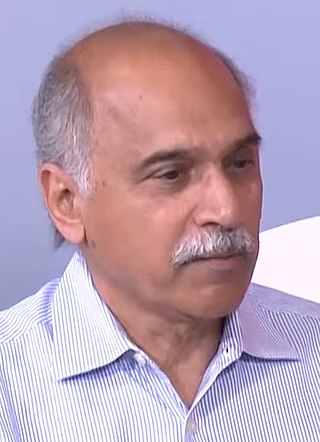
Steven Weinberg was an American theoretical physicist and Nobel laureate in physics for his contributions with Abdus Salam and Sheldon Glashow to the unification of the weak force and electromagnetic interaction between elementary particles.

Owen Chamberlain was an American physicist who shared with Emilio Segrè the Nobel Prize in Physics for the discovery of the antiproton, a sub-atomic antiparticle.

David Jonathan Gross is an American theoretical physicist and string theorist. Along with Frank Wilczek and David Politzer, he was awarded the 2004 Nobel Prize in Physics for their discovery of asymptotic freedom. Gross is the Chancellor's Chair Professor of Theoretical Physics at the Kavli Institute for Theoretical Physics (KITP) of the University of California, Santa Barbara (UCSB), and was formerly the KITP director and holder of their Frederick W. Gluck Chair in Theoretical Physics. He is also a faculty member in the UCSB Physics Department and is currently affiliated with the Institute for Quantum Studies at Chapman University in California. He is a foreign member of the Chinese Academy of Sciences.

Nima Arkani-Hamed is an American-Canadian theoretical physicist of Iranian Persian descent, with interests in high-energy physics, quantum field theory, string theory, cosmology and collider physics. Arkani-Hamed is a member of the permanent faculty at the Institute for Advanced Study in Princeton, New Jersey. He is also director of the Carl P. Feinberg Cross-Disciplinary Program in Innovation at the Institute and director of The Center for Future High Energy Physics (CFHEP) in Beijing, China.

Geoffrey Foucar Chew was an American theoretical physicist. He is known for his bootstrap theory of strong interactions.

John David Jackson was a Canadian–American physics professor at the University of California, Berkeley and a faculty senior scientist emeritus at Lawrence Berkeley National Laboratory.
The MIT Center for Theoretical Physics (CTP) is the hub of theoretical nuclear physics, particle physics, and quantum information research at MIT. It is a subdivision of MIT Laboratory for Nuclear Science and Department of Physics.
William Rarità was an American theoretical physicist who mainly worked on nuclear physics, particle physics and relativistic quantum mechanics. He is particularly famous for the formulation of Rarita–Schwinger equation. His famous formula is applicable to spin 3/2 particles as opposed to spin 1/2 particles. Rarita taught physics at Brooklyn College for 32 years before he became a visiting scientist in the theory group at LBNL. At the time of his retirement in 1996, he was doing research at LBNL. In addition to his work with Julian Schwinger, Rarita also collaborated with Herman Feshbach.

The MIT Department of Physics has over 120 faculty members, is often cited as the largest physics department in the United States, and hosts top-ranked programs. It offers the SB, SM, PhD, and ScD degrees. Fourteen alumni of the department and nine current or former faculty members have won the Nobel Prize in Physics.

Helen Rhoda Arnold Quinn is an Australian-born particle physicist and educator who has made major contributions to both fields. Her contributions to theoretical physics include the Peccei–Quinn theory which implies a corresponding symmetry of nature and contributions to the search for a unified theory for the three types of particle interactions. As Chair of the Board on Science Education of the National Academy of Sciences, Quinn led the effort that produced A Framework for K-12 Science Education: Practices, Crosscutting Concepts, and Core Ideas—the basis for the Next Generation Science Standards adopted by many states. Her honours include the Dirac Medal of the International Center for Theoretical Physics, the Oskar Klein Medal from the Royal Swedish Academy of Sciences, appointment as an Honorary Officer of the Order of Australia, the J. J. Sakurai Prize for Theoretical Particle Physics from the American Physical Society, the Karl Taylor Compton Medal for Leadership in Physics from the American Institute of Physics, and the 2018 Benjamin Franklin Medal in Physics from the Franklin Institute.
The Stanford Institute for Theoretical Physics (SITP) is a research institute within the Physics Department at Stanford University. Led by 16 physics faculty members, the institute conducts research in High Energy and Condensed Matter theoretical physics.

Giorgio Parisi is an Italian theoretical physicist, whose research has focused on quantum field theory, statistical mechanics and complex systems. His best known contributions are the QCD evolution equations for parton densities, obtained with Guido Altarelli, known as the Altarelli–Parisi or DGLAP equations, the exact solution of the Sherrington–Kirkpatrick model of spin glasses, the Kardar–Parisi–Zhang equation describing dynamic scaling of growing interfaces, and the study of whirling flocks of birds. He was awarded the 2021 Nobel Prize in Physics jointly with Klaus Hasselmann and Syukuro Manabe for groundbreaking contributions to theory of complex systems, in particular "for the discovery of the interplay of disorder and fluctuations in physical systems from atomic to planetary scales".

George Fitzgerald Smoot III is an American astrophysicist, cosmologist, Nobel laureate, and the second contestant to win the $1 million prize on Are You Smarter than a 5th Grader?. He won the Nobel Prize in Physics in 2006 for his work on the Cosmic Background Explorer with John C. Mather that led to the "discovery of the black body form and anisotropy of the cosmic microwave background radiation".

Carl Richard Hagen is a professor of particle physics at the University of Rochester. He is most noted for his contributions to the Standard Model and Symmetry breaking as well as the 1964 co-discovery of the Higgs mechanism and Higgs boson with Gerald Guralnik and Tom Kibble (GHK). As part of Physical Review Letters 50th anniversary celebration, the journal recognized this discovery as one of the milestone papers in PRL history. While widely considered to have authored the most complete of the early papers on the Higgs theory, GHK were controversially not included in the 2013 Nobel Prize in Physics.
The Santa Cruz Institute for Particle Physics (SCIPP) is an organized research unit within the University of California system focused on theoretical and experimental high-energy physics and astrophysics.

Mary Katharine Gaillard is an American theoretical physicist. Her focus is on particle physics. She is a professor of the graduate school at the University of California, Berkeley, a member of the Berkeley Center for Theoretical Physics, and visiting scientist at the Lawrence Berkeley National Laboratory. She was Berkeley's first tenured female physicist.

Ramamurti Shankar is the Josiah Willard Gibbs professor of Physics at Yale University, in New Haven, Connecticut.
Bryan Ronald Webber, FRS, FInstP is a British physicist and academic. He was a Fellow of Emmanuel College, Cambridge from 1973 to 2010, and Professor of Theoretical Physics at the University of Cambridge from 1999 to 2010. He has been awarded the Dirac Medal by the Institute of Physics, the Sakurai Prize by the American Physical Society and the High Energy and Particle Physics Prize by the European Physical Society.
The Gribov Medal is a prize awarded every two years since 2001 by the European Physical Society for work in theoretical elementary particle physics or quantum field theory. It is awarded to younger physicists and is named after Vladimir Naumovich Gribov.
Warren Bicknell Mori is an American computational plasma physicist and a professor at the University of California, Los Angeles. He was awarded the 2020 James Clerk Maxwell Prize for Plasma Physics for his contributions to the theory and computer simulations of non-linear processes in plasma-based acceleration using kinetic theory, as well as for his research in relativistically intense lasers and beam-plasma interactions.











